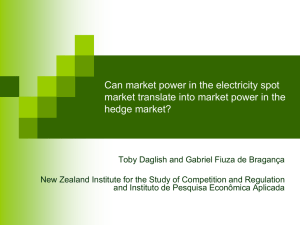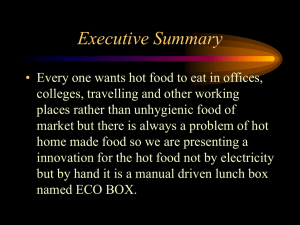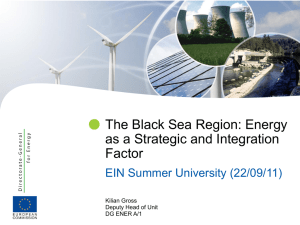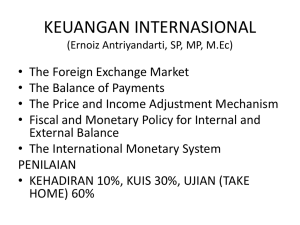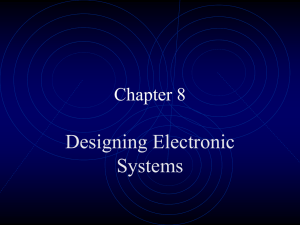Slide - ATE - Massey University
advertisement
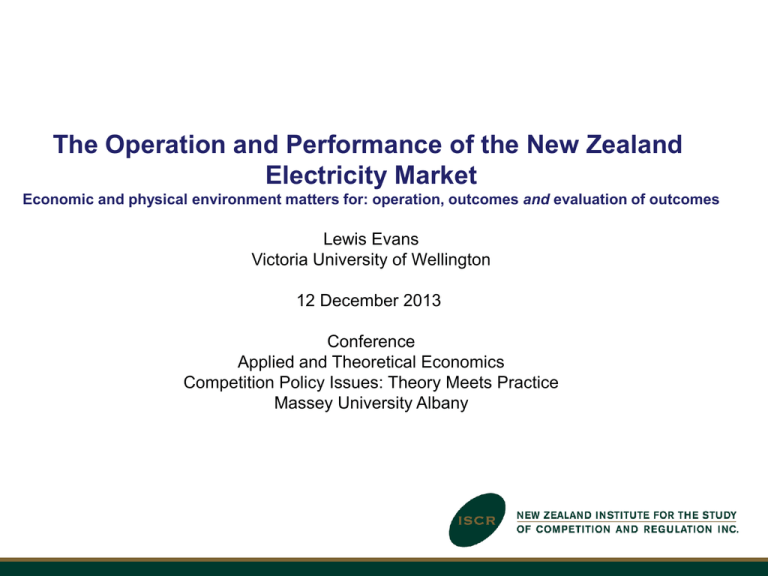
The Operation and Performance of the New Zealand Electricity Market Economic and physical environment matters for: operation, outcomes and evaluation of outcomes Lewis Evans Victoria University of Wellington 12 December 2013 Conference Applied and Theoretical Economics Competition Policy Issues: Theory Meets Practice Massey University Albany Outline 1. The Market 2. Forms of risk and implications for 1. Market performance 2. Modelling market performance 3. One approach: or how the spot market allocates water (and gas) 4. Comment on performance NZ Electricity Market 2013 Energy only Market, no taxpayer-as-taxpayer- funded investment, risks assigned to those best able to manage them Households produce the peaks Oligopoly: 5 large firms + fringe competition: workable Generation Customers Transmission competition. 1/3 households and 1/3 commercial firms & 1/3 large industrials (Retail) (National HV Grid) Natural monopoly SOE (investment/prices regulated by the Commerce Commission) (Local LV Grid) Natural monopoly Distribution (cooperatives/regulation Commerce Commission) Buyers & Sellers • 14 retailers (4 not gentailers: 22 brands) • Generation – Greater than 1MW: there are 140 plant owned by 36 separate companies (operated by 19) – Less than 1MW: small (at least 80, micro plant embedded in networks) • Traders spot: 32 distinct buyers or sellers • Traders Futures (ASX): 12 distinct traders: 5 of which are not market participants Source EA June 2013 Managing Volatility and Its Implications The wholesale market: spot, forward and capacity Anticipated Spot price characteristics Supply cost of generation plant/fuel, Demand, Climate and events The Future Capacity Investment Spot Prices Forward Prices Inflows, Storage Short term demand supply and transmission events The Present Volatility Indicator Vector North Gas Pipeline: Daily Gas Throughput Volatility (thermal generation: water/temperature): across years/seasons/weeks ( source Concept Consulting) 70.00 01/07/31 01/10/33 01/01/36 01/04/38 01/07/40 01/10/42 01/01/45 01/04/47 01/07/49 01/10/51 01/01/54 01/04/56 01/07/58 01/10/60 01/01/63 01/04/65 01/07/67 01/10/69 01/01/72 01/04/74 01/07/76 01/10/78 01/01/81 01/04/83 01/07/85 01/10/87 01/01/90 01/04/92 01/07/94 01/10/96 01/01/99 01/04/01 01/07/03 01/10/05 NZ-specific characteristic 60% is hydro generation with limited storage and very volatile water supplies There is huge variation Monthly Inflows 1931-2006 (GWhrs/100) 60.00 50.00 40.00 30.00 20.00 10.00 0.00 Regional Water Flow Characteristics Implications: I 1. The risky economic environment enhances competition in the spot and hedge markets: different firms have different cost structures (water and other) that vary unpredictably over time rendering cooperation more difficult 2. Hedging will be an integral part of the wholesale market: 1. Across time 2. Across space 3. In competition with capacity investment (in generation and storage) More on: Spot and Hedge Prices • Transactions occur largely at value the fixed hedge price water The spot electricity price => of unit of stored • Generators are short of water in dry years: which can A hedge (for some quantity) and spot prices be$50 very costly Spot market is a nationwide water market valuing use • The high price episodes do not imply market power or in electricity rent to generators We observe no dry-year generator cash profit humps Generators and Buyers can each win and lose with dry weather Operating Cash Flow (excluding interest) After tax, before capex, asset, financing transactions. In $m. constant (cpi) prices and aggregate spot throughput (Contact 2005 9mths) 1400 1200 1000 Trustpower 800 Mighty River 600 Meridian 400 Genesis 200 Contact Energy 0 FY2002 FY2003 FY2004 FY2005 FY2006 FY2007 FY2008 FY2009 FY2010 FY2011 FY2012 Implications: II 1. Spot market-measured profit distribution outcomes in general do not translate into actual profit distribution outcomes in the long or short run 2. Modelling the spot market should 1. explicitly recognise uncertainty 2. recognise that decisions by generators will be taken in trading periods based on information that includes * amount of stored water, * inflows and * forecastability of inflows (at least days – or many trading periods – ahead) Application A(nother) model of the spot market in continuous time Model: behaviour • Competitive behaviour equivalent to social planner choice • For any trading period choose on- and off-peak hydro and gas generation to maximise the expected present value of total surplus: - looking forward to the indefinite future - given the model’s structure, the distribution forecastibility of inflows, levels of current inflow and storage - given a defined opportunity cost of gas, & ignoring competing uses for water • Planner’s choice produces gas and hydro generation policies Model: generation policies in each trading period • The combined cost of hydro and gas generation is minimised and consumer price equals marginal cost (typically) of water and gas • The spot market valuation of water is the price of the last unit of stored water that renders generators indifferent between generating today or waiting: ie value of use today equals - the expected present value of use in some future period, and - the value of the option to use in the future Model: Value of Water Model calibrated to 2007 Outcomes from 200 years of simulated daily (full trading) periods s • is the proportion of storage to capacity • The upper curve relates to very low inflows • The lower curve relates to very high inflows Model: Generation Policies: Dry Year: all gas used before hydro Demand 1 Demand 2 Marginal cost Price Gas Water Given storage Demand predictable Model: Generation Policies: Normal Year gas then hydro then gas Demand 1 Demand 2 Marginal cost Price Gas Water Given storage Demand predictable Implications: III Where there is significant volatility in water (gas) supplies and storage 1. a rational expectations spot market has no exogenous supply curve: the level of demand affects storage and the position of the supply curve (no matter how competitive the market) 2. studies of particular outcomes have limitations in that decisions are forward looking in the context of variance & risk: improvable realised outcomes do not of themselves indicate choices were inefficient. Model: Intra Day Spot Market Water Allocation light-shade without reservoir || dark-shade with reservoir Outcomes from simulations Model: Seasonal Water Allocation light-shade without reservoir || dark-shade with reservoir Outcomes from simulations: Implications: IV The spot market has a socially useful role 1. Complements hedges providing transactions in unders/overs 2. Prices water in electricity production in almost real time across regions 3. Allocates water (relative to gas) over time in electricity The model described has uses based on a presumption of efficient decisions: could be tested on distribution of outcomes. Comment on Performance The Hedge/Contract Market Evidence is a) that hedge price closely approximates next cheapest generation option: as it should in a stable/growing market. b) Capacity investment has matched supply to demand, The NZ Cost of Electricity Comparisons across Countries [EA March 2013] Are fraught with issues a) definitional what is the price paying for? b) exchange rate issues: why vary them over time? (adjusting for the change in the TWI since 1999 NZ has the same ranking in 2012 as in 1999) c) domestic fuel supply conditions Factors Affecting Residential prices 1990-2013 • Better reflect cost of electricity delivery • Corporatisation changing the subsidy->price • Peakiness requiring capacity • Open ended contracts (insurance) • Competition in retail and the wider market Harker 2013 Final Comments •Present arrangements: the electricity market has technological change in prospect that creates risk and the prospect of beneficial outcomes •Regulatory Risk: the subsidy-single buyer model has two strands: a subsidy for electricity, and return to government management of the market. It has deleterious effects on economic performance and the environment. It is most unlikely to foster beneficial outcomes of technological advance. Bibliography Concept Consulting Group, Gas Supply and Demand Scenarios, 2012 – 2017, 2012, 122p. Evans Lewis, Graeme Guthrie and Angela Lu, “The Role of Storage in a Competitive Electricity Market and the Effects of Climate Change”, Energy Economics, 36, 2013, 405-418. ----, Seamus Hogan and Peter Jackson, “A Critique of Wolak’s evaluation of the NZ electricity market: introduction and overview”, New Zealand Economic Papers, 46(1), 2012, 1-11. Introduction to a symposium of several papers on Frank Wolak’s Commerce Commission consulting report. ---- and Graeme Guthrie, "How Options Provided by Storage Affect Electricity Prices”, Southern Economic Journal, 75(3), 2009, 681-702. -----, The Economic Effects of the Price-Discriminating Single Buyer : Presentation to the Victoria University Institute of Policy Studies, (www.iscr.org.nz), July, 2013. Grimm Veronika, and Gregor Zoettl, Investment Incentives and Electricity Spot Market Competition, Journal of Economics and Management Strategy, 22(4) 2013. Harker, Bruce, Address to Trustpower AGM, July 2013 (www.nzx.com/companies/TPW/announcements/239025) Philpott, Andy and Ziming Guan, “Models for Estimating the performance of electricity markets with hydroelectric Reservoir Storage”, mimeo, EPOC, Auckland University, 2013, 44p.

